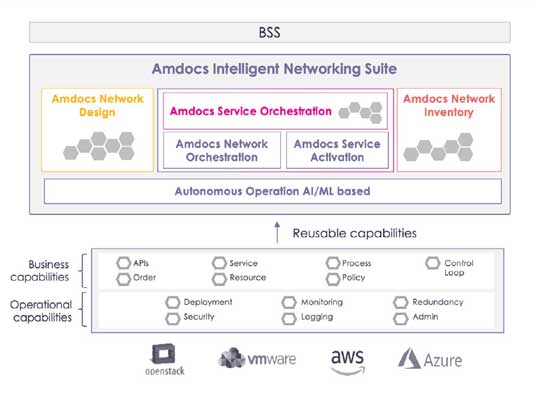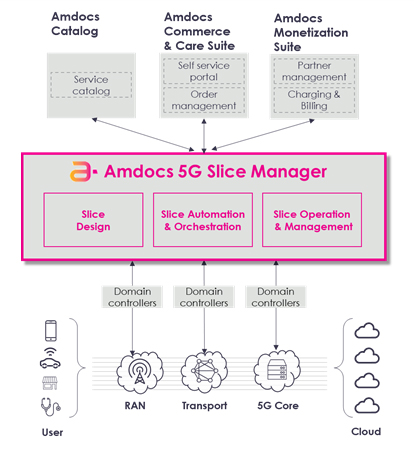Eyal Shaked gives his view on how 5G takes hyperscaler and telco cooperation to the next level.
5G, Telcos, and the Cloud
Telcos are no strangers to cloud. Major telcos around the globe operate proprietary clouds that provide the network functions virtualization infrastructure (NFVI) for software-defined networking (SDN) and virtual network functions (VNFs)—all of which allow telcos to deliver agile, flexible, and reliable network services. The emergence of cloud-native network functions (CNFs) that run inside containers (versus VNFs that run on VMs) is yet another important milestone on the telco journey toward cloud-native architectures.
Recently, the rolling out of their 5G Cores has made it compellingly clear to telcos that strategic partnerships with public cloud hyperscalers can accelerate their time-to-value. The stakes are high, considering the wide range of 5G use cases to be fulfilled, from content delivery and augmented/virtual reality to IoT-based smart vertical solutions and driverless cars. But telcos are also wary of the dangerous impact this kind of strategic cooperation can have on their place in the value chain—reducing them to a “dumb pipe” while hyperscalers provide all the value-added services.
This blog post describes the 5G rollout challenges and brings real-life examples that demonstrate the benefits to telcos (and hyperscalers) of these 5G core-to-edge partnerships. It also describes the Amdocs’ network and service orchestration platform, which is already integrated with both AWS and Azure.
5G rollout challenges
R&D on 5G started in earnest a little less than 10 years ago, just as 4G LTE network rollouts were being completed. Forward-looking CSPs, network appliance vendors, mobile and IoT device OEMs, cloud-native application vendors, and hyperscalers began working together to make 5G a reality, with its promise of:
- Ubiquitous and super-fast internet access
- Huge bandwidth to handle the endless two-way flow of big data
- Multi-access Edge Computing (MEC) to support high-performance edge computing at scale
- Network slicing from core to edge to facilitate use-case-based SLAs
- Ultra-Reliable Low-Latency Communication (URLLC) for mission-critical applications
- The agility and flexibility of a cloud-native microservice-based architecture
However, as the CSPs progress along the path to full-fledged, standalone, high-band 5G networks, they find themselves facing the following challenges:
- Complexity: Telcos and CSPs need to operate and maintain complex networks that encompass 3G, 4G, and 5G. This complexity creates infrastructure, software, and operational bottlenecks that constrain new initiatives.
- Lack of agility: For the most part, telcos and CSPs still use legacy maintenance processes that cannot keep up with the speed and flexibility of a 5G network.
- Growing strength of over-the-top (OTT) players: 5G network capabilities further strengthen the OTT players, who have already disrupted traditional telco (and broadcast) business models by decoupling content, messaging, and voice/video services from the infrastructure over which they are delivered.
- Emergence of private mobile networks and innovative startups: The unprecedented move to open up 5G spectrums—such as the Citizens Broadband Radio Service (CBRS) "innovation band" in the U.S. or the industrial spectrums in Germany and Japan—encourages the launch of innovative 5G apps and services that run on their own 5G network. It also allows enterprises to create dedicated 5G networks.
CSPs can address many of these challenges by partnering with hyperscalers to leverage their scalable and reliable core-to-edge infrastructures, cost-effective on-demand business models, fully managed platforms, and rich partner ecosystems. However, these partnerships are a double-edged sword because value propositions become blurred as hyperscalers and telcos start to offer overlapping and competing services. A classic example is AWS’ recent announcement of their own fully managed AWS Private 5G network.
The multi-billion-dollar question becomes, how can CSPs cooperate with hyperscalers without undermining their own position in the value chain?
Examples of CSP/Hyperscaler 5G Partnerships
Below, we present two case studies that illustrate how leading CSPs such as AT&T and DISH are forging strategic partnerships with cloud hyperscalers in order to accelerate and enrich their 5G deployments. With these partnerships, everybody wins: The CSP leverages proven hyperscaler infrastructure resources and managed services, the hyperscaler becomes a part of the 5G value chain, and third parties get a powerful end-to-end platform for bringing innovative 5G applications to market.
AT&T and Azure
To date, AT&T has virtualized 75% of its network functions, making it an industry leader in software-defined networking (SDN). It has also been a major contributor to pivotal and innovative open-source projects such as ONAP (Open Network Automation Platform), DANOS (Disaggregated Network Operation System), and Akraino (open blueprints for edge computing systems and applications).
In July 2021, AT&T announced that it will be hosting its 5G mobile network on the Microsoft Azure for Operators cloud. According to the terms of the agreement, Microsoft and AT&T personnel will work closely together, leveraging AT&T’s considerable SDN-related IP. Microsoft will be responsible for delivering a high-performance network cloud on which AT&T will directly manage its subscriber data as well as its network and application deployments—including the rollout of its 5G services.
The key benefits of this hyperscaler/telco partnership are:
- AT&T’s expertise and experience will accelerate the evolution of Microsoft Azure for Operators, for the benefit of all CSPs making the transition to 5G.
- AT&T can concentrate on building out its cloud-native 5G network at scale.
- Each side brings a rich partner network and substantial enterprise customer base to the table, for best-of-breed synergies and new business opportunities.
DISH and AWS
DISH Network Corporation (NASDAQ: DISH) was established in 1980 as a connectivity company with a focus on satellite television. Since 2020, it has been a U.S.-wide wireless carrier, starting with its acquisition of Sprint’s prepaid business division.
In April 2021, DISH and AWS announced a strategic collaboration whereby AWS will host DISH’s standalone, cloud-based 5G O-RAN (Open Radio Access Network) in the U.S. Leveraging AWS Local Zones (enabling the deployment of AWS services on infrastructure that is close to end users) and AWS Outposts (fully managed AWS infrastructure, services, and APIs deployed on-premises or at the edge), DISH will deploy its 5G Core at the edge for reliable and consistent low-latency performance. The first city to go live will be Las Vegas, in early 2022.
The key benefits of this hyperscaler/CSP partnership are:
- DISH can leverage AWS’ compute, container, IoT, machine learning, and security capabilities to cost-effectively run its 5G Core and its business and operations systems (BSS/OSS) at scale.
- DISH can cooperate with AWS Professional Services and AWS’ telco partners to achieve high levels of automation in deploying 5G network slices to meet tailored SLAs and use cases.
- Developers can take advantage of the combined DISH/AWS capabilities to quickly bring innovative 5G applications to market.
Amdocs Intelligent Networking Suite and Hyperscalers
Amdocs Intelligent Networking Suite: An Overview
The Amdocs Intelligent Networking Suite facilitates the design, inventory, and orchestration of CSP services for physical, logical, and virtual elements. It supports diverse lines of business, including mobile, consumer broadband, and enterprise/B2B, as well as NFV and 5G-based services.
The suite is based on and supports leading industry standards, including ETSI, TMF, ONAP, and 3GPP. It provides a highly available, carrier-grade platform with advanced logging, self-monitoring, and self-healing capabilities. The modular, microservice-based platform is easily extensible and configurable.
The main components of the Amdocs Intelligent Networking Suite are summarized below:
- Amdocs Network Design is a graphical design and configuration environment to design services, products, workflows, and orchestration processes. Existing PNFs/VNFs/CNFs are easily onboarded to accelerate the design process. The Amdocs orchestrator uses the catalog of network service, function, and resource models when deploying instances on a live network.
- Amdocs Service Orchestration instantiates and fulfills services (based on predefined models and policies) across diverse LOBs, while Amdocs Network Orchestration provisions and configures network elements for different network operational domains, such as RAN, Transport, and 5G Core.
- Amdocs Network Inventory provides federated, real time views of network elements and topology across both Amdocs and third-party inventory systems.
- Amdocs Network Assurance is a control loop that uses monitoring agents to detect service or network element performance problems and automatically trigger corrective actions.
Amdocs Intelligent Networking Suite on AWS and Azure
Amdocs has strengthened its collaboration with hyperscalers such as AWS and Azure, enabling its customers to deploy its Intelligent Networking Suite products on their public clouds. Consequently, customers can leverage native cloud services for faster deployment, shorter upgrade cycles, lower TCO, accelerated time-to-market for innovative services, on-demand scalability, enhanced resiliency, and streamlined operations.
Several operators around the world have already deployed Amdocs’ cloud-native Intelligent Networking Suite on AWS and benefit from AWS services that add business and operational capabilities to the suite such as:
- Amazon Managed Streaming for Apache Kafka (MSK) to securely stream data
- Amazon Elastic Kubernetes Service (EKS) to run and scale containerized applications
- Amazon OpenSearch Service (formerly Amazon Elastic search Service) for big data analytics
- Amazon Relational Database Service (RDS) for scalable relational databases
- AWS CloudFormation for infrastructure-as-code provisioning
Amdocs also collaborates with Microsoft so that CSPs can leverage Azure for Operators to migrate to transformative cloud-native solutions, automate and virtualize their network, and deploy 5G networks from core to edge. With Amdocs Intelligent Networking Suite on Azure for Operators, CSPs can use Azure to orchestrate their 5G network functions and applications and accelerate service innovation. In this way they can drive business growth beyond simple connectivity, offering advanced capabilities such as private enterprise networks (PEN) and multi-access edge computing (MEC).
5G Network Slicing Use Case
Figure 2 illustrates how Amdocs Intelligent Networking Suite, integrated with ordering and charging, addresses the operational complexities of 5G network slicing, providing an end-to-end management and monetization solution for the network slice lifecycle.
The Amdocs Intelligent Networking Suite’s 5G Slice Manager supports:
- Business and customer-centric slice segmentation
- End-to-end lifecycle automation for cross-domain, multi-vendor network slicing
- Adaptive network and processes that respond in real time to dynamic requirements
Conclusion
Given the cloud-native architecture of 5G Core and the data-intensive, cloud-to-edge use cases it is designed to support, it is not surprising that strategic partnerships are being forged between public cloud hyperscalers and telcos as 5G networks are rolled out around the globe. 5G is forcing telcos out of their private cloud comfort zones as they seek to accelerate the ROI on their huge investments in 5G networking infrastructure and operational services.
However, these partnerships are a double-edged sword. On the one hand, they help the telcos overcome the complexity of operating multi-generational networks; embrace more agile and flexible provisioning and maintenance processes; and stay competitive in the face of 5G-empowered OTT players, private mobile networks, and innovative startups. On the other hand, the partnerships could obscure the unique role of the telcos in 5G value creation and constrain their positioning in the new 5G economy.
Amdocs Intelligent Networking Suite is an end-to-end solution for designing, operating, and orchestrating telco services across physical, logical, and virtual network elements. The Amdocs platform is fully integrated with both AWS and Azure for faster service deployments, shorter upgrade cycles, lower TCO, quicker time-to-innovation, and enhanced scalability and resiliency.
Contact an Amdocs specialist to learn how Amdocs Intelligent Networking Suite can help you re-align yourself effectively in the brave new 5G world.





